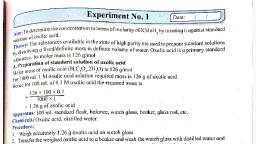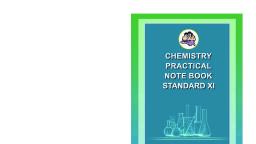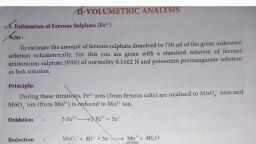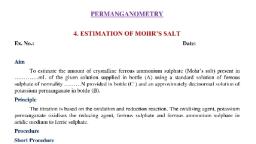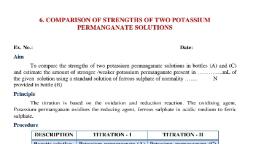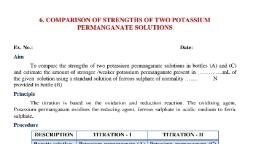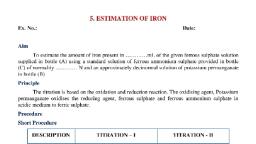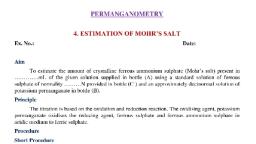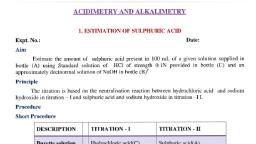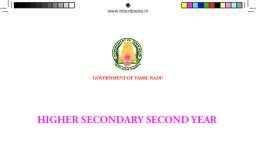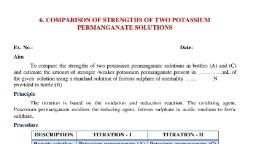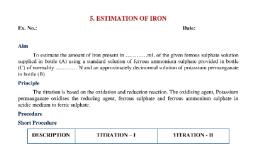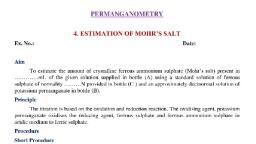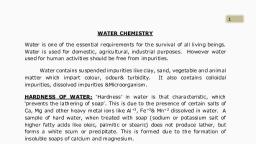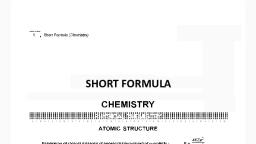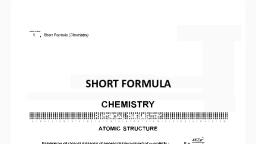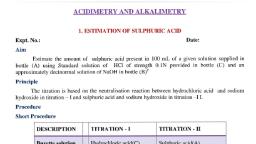Page 2 :
OXIDATION & REDUCTION, Oxidation Number :, It is the charge (real or imaginary) which an atom appears to have when it is in combination. It may be a, whole no. or fractional. An element may have different values of oxidation number depending . It depends, on nature of compound in which it is present. There are some operational rules to determine oxidation, number., Oxidation :, Addition of oxygen , removal of hydrogen , addition of electro negative element , removal of electro positive element , loss of electrons , increase in oxidation number (deelectronation) ., Reduction :, Removal of oxygen, addition of hydrogen, removal of electronegative element, addition of electro +ve, element, gain of electrons, decrease in oxid. no. (electronation)., Redox Reactions :, A reaction in which oxidation & reduction occur simultaneously ., Oxidising Agents :, (oxidants, oxidisors). They oxidise others, themselves are reduced & gain electrons. eg. O2, O3, HNO3,, MnO2, H2O2, halogens, KMnO4, K2Cr2O7, KIO3, Cl(SO4)3, FeCl3, NaOCl, hydrogen ions., [Atoms present in their higher oxidation state.], Reducing Agents :, H2, molecular form is weak reducing agent but Nascent hydrogen is powerful . C, CO, H2S, SO2,, SnCl2, Sodium thio Sulphate, Al, Na, CaH2, NaBH4, LiAlH4 . They reduce others, themselves get, oxidised & lose electrons. Also called reductants or reducers ., [Atoms present in their lower oxidation state.], Both Oxidising & Reducing Agents :, SO2 , H2O2 , O3 , NO2 , etc ., Balancing Of Equations :, (i), Ion - electron method, (ii), Oxidation number method, [Concept involved that in any chemical reaction e– cannot be produced so no. of e–s in O.H. & R.H., should be same], NOTE : To predict the product of reaction remember :, (a), Free halogen on reduction gives halide ion (F2 F ), (b), , Alkali metals on oxidation give metallic ion with + 1 oxidation state., , (c), (d), , In alkaline medium it is reduced to K2MnO4 but in strong alkaline or neutral medium it reduces to Mn+4., In acid solution KMnO4 is reduced to Mn2+., , (e), , H2O2 on reduction gives water and on oxidation gives oxygen., , (f), , Dichromate ion in acid solution is reduced to Cr3+., , Nature Of Oxides Based On Oxidation Number :, Lowest oxidation state, Intermediate oxidation state, Highest oxidation state, , Basic, Amphoteric, Acidic, , (MnO), (Mn3O4 , MnO2), (Mn2O7), , Redox & Equivalent Concepts (Stochiometry-II), , [2]
Page 3 :
Rules, (i), (ii), (iii), (iv), (v), (vi), (vii), (viii), (ix), (x), , For Assigning Oxidation Number :, Oxidation number of free elements or atoms is zero ., Oxidation number of allotropes is zero ., Oxidation number of atoms in homo-nuclear molecules is zero ., Oxidation number of mono-atomic ions is equal to the algebric charge on them ., Oxidation number of F in compounds is - 1 ., Oxidation number of H in its compounds is + 1 , except in metalhydrides where it is - 1 ., Oxidation number of O is - 2 in its compounds , but in F2O it is + 2 and in peroxides it is - 1 and - 0.5 in KO2 ., Oxidation number of alkali metals in their compounds + 1 ., Oxidation number of alkaline earth metals in their compounds is + 2 ., The sum of oxidation number of all the atoms in a molecule should be zero and in an ion equal to itscharge ., , Average Oxidation Number : Find Oxidation Number of Fe in Fe3O4 ., Fe3O4 is FeO. Fe2O3., O. N. of Fe in FeO is + 2, ;, O. N. of Fe in Fe2O3 is + 3 ., Therefore average O. N. of three Fe atoms =, , 22x( 3), 8, = ., 3, 3, , EQUIVALENT CONCEPT, (A) Volumetric analysis :, This mainly involve titrations based chemistry. It can be divided into two major category., (I) Non-redox system, (II) Redox system, (I) Non – redox system, This involve following kind of titrations:, 1., Acid-Base titrations, 3., Precipitation titration, , 2., 4., , Back titration, Double indicator acid base titration, , Titrimetric Method of Analysis : A titrimetric method of analysis is based on chemical reaction such as., aA + tT Product, Where ‘a’ molecules of “analysis”, A, reacts with t molecules of reagent T., T is called Titrant normally taken in buret in form of solution of known concentration. The solution of, titrant is called “standard solution”., The addition of titrant is added till the amount of T, chemically equivalent to that of ‘A’ has been added., It is said equivalent point of titration has been reached. In order to know when to stop addition of titrant,, a chemical substance is used called indicator, which respond to appearance of excess of titrant by, changing colour precisely at the equivalence point. The point in the titration where the indicator changes, colour is termed the ‘end point’. It is possible that end point be as close as possible to the equivalence, point.The term titration refer’s to process of measuring the volume of titrant required to reach the end, point., Law of Chemical equivalence:, It states that in any chemical reaction the equivalents of all the reactants and products must be same., 2A + 3B 4C, Eg. of A = Equivalents of ‘B’ = Equivalents of ‘C’, Weight of ' A ', Equivalents of ‘A’ = Equivalent weight of ' A ', , or, , Equivalents of ‘A’ = no. of moles of ‘A’ × n-factor, , Redox & Equivalent Concepts (Stochiometry-II), , [3]
Page 4 :
n-factor calculation, n factor here we mean a conversion factor by which we divide molar mass of substance to get equivalent, mass and it depends on nature of substance which vary from one condition to another condition. We can, divide n-factor calculations in two category., (A) In case of non-redox reaction., (B) In case of redox reaction., Acid-Base titration, To find out strength or concentration of unknown acid or base it is titrated against base or acid of known, strength. At the equivalence point we can know amount of acid or base used and then with the help of, law of equivalents we can find strength of unknown., Meq of acid at equivalence point = Meq of base at equivalence point, Back titration, Back titration is used in volumetric analysis to find out excess of reagent added by titrating it with suitable, reagent. It is also used to find out percentage purity of sample. For example in acid-base titration, suppose we have added excess base in acid mixture. To find excess base we can titrate the solution with, another acid of known strength., Precipitation titration :, In ionic reaction we can know strength of unknown solution of salt by titrating it against a reagent with, which it can form precipitate. For example NaCl strength can be known by titrating it against AgNO3, solution with which it form white ppt. of AgCl., So meq. of NaCl at equivalence point = meq of AgNO3 used = meq of AgCl formed, Note:, When we carry out dilution of solution, meq eq, milli mole or mole of substance does not change because, they represent amount of substance, however molar concentration may change., , Redox & Equivalent Concepts (Stochiometry-II), , [4]
Page 6 :
GLOSSARY, Aliquot. A portion of the whole, usually a simple fraction. A portion of a sample withdraw from a volumetric flask, with a pipet is called an aliquot., Analytical concentration. The total number of moles per litre of a solute regardless of any reactions that might, occur when the solute dissolves. Used synonymously with formality., Equivalent. The amount of a substance which furnishes or reacts with 1 mol of H+ (acid-base), 1 mol of, electrons (redox), or 1 mol of a univalent cation (precipitation and complex formation)., Equivalent weight. The weight in grams of one equivalent of a substance., Equivalence point. The point in a titration where the number of equivalents of titrant is the same as the number, of equivalents of analyte., End point. The point in a titration where an indicator changes color., Formula weight. The number of formula weights of all the atoms in the chemical formula of a substance., Formality. The number of formula weights of solute per litre of solution; synonymous with analytical, concentration., Indicator. A chemical substance which exhibits different colors in the presence of excess analyte or titrant., Normality. The number of equivalents of solute per litre of solution., Primary standard. A substance available in a pure form or state of known purity which is used in standardizing, a solution., Standardization. The process by which the concentration of a solution is accurately ascertained., Standard solution. A solution whose concentration has been accurately determined., Titrant. The reagent (a standard solution) which is added from a buret to react with the analyte., , Redox & Equivalent Concepts (Stochiometry-II), , [6]
Page 7 :
EXERCISE I, Acid Base Titration, Q.1, , Calculate volume of 1N H3PO4 required to react with 20ml 2N Ca(OH)2 solution., , Q.2, , Calculate volume of 1N H2SO4 required to react with 20ml 1M Al(OH)3 solution., , Q.3, , Calculate volume of 0.4 M NaOH required to react with following mixture, HCl (1 mol) + H2SO4 (2 mol), , Q.4, , Calculate volume of 0.2 M H2SO4 required to ract with following mixture, NaOH (1mol) + Ca(OH)2 (2 mol), , Q.5, , A solution containing 4.2 g of KOH and Ca(OH)2 is neutralized by an acid. It consumes 0.1 equivalent, of acid, calculate the percentage composition of the sample., , Q.6, , How many ml of 0.1 N HCl are required to react completely with 19 gm mixture of Na2CO3 and, NaHCO3 containing equimolar amounts of two?, , Q.7, , H3PO4 is a tri basic acid and one of its salt is NaH2PO4. What volume of 1 M NaOH solution should be, added to 12 g of NaH2PO4 to convert it into Na3PO4?, Redox Titration, , Q.8, , It requires 40 ml of 1M Ce4+ to titrate 20ml of 1M Sn2+ to Sn4+. What is the oxidation state of the, cerium in the product., , Q.9, , A volume of 10.0 ml of 1 M SeO2 reacted with exactly 20 ml of 2 M CrSO4. In the reaction, Cr2+ was, oxidized to Cr3+. To what oxidation state was selenium converted by the reaction., , Q.10 Potassium acid oxalate K2C2O4 · 3H2C2O4·4H2O can be oxidized by MnO4– in acid medium. Calculate, the volume of 0.1M KMnO4 reacting in acid solution with 5.08 gm of the acid oxalate., Q.11, , A 1 g sample of H2O2 solution containing x % H2O2 by mass requires x cm3 of a KMnO4 solution for, complete oxidation under acidic conditions. Calculate the normality of KMnO4 solution., , Q.12 Metallic tin in the presence of HCI is oxidized by K2Cr2O7 to stannic chloride, SnCl4. What volume of, deci-normal dichromate solution would be reduced by 11.9 gm of tin. [Sn = 119], Q.13 Calculate the number of millimoles of K2Cr2O7 which will completely react with 40 ml 0.1 M KI solution., Q.14 Calculate volume of 0.4 M KMnO4 required to react with following in acidic medium., KHC2O4 (1 mol) + H2C2O4 (2 mol), Q.15 Calculate volume of 0.4 M NaOH required to react with following mixture., KHC2O4 (1 mol) + H2C2O4 (2 mol), Q.16 Calculate volume of 0.2 M KMnO4 required to react with following mixture in acidic medium., KHC2O4 (128 gm) + H2C2O4 (180 gm), Redox & Equivalent Concepts (Stochiometry-II), , [7]
Page 8 :
Q.17 520 gm mixture of Fe2O3 & FeO reacts completely with 158 gm KMnO4 in acidic medium. Calculate, the mole % of Fe2O3 in mixture., Q.18 Calculate the millimoles of Br2 produced when 10 ml of 0.1 M BrO3¯ reacts with excess of Br¯., Q.19 5g sample of brass was dissolved in one litre dil. H2SO4. 20 ml of this solution were mixed with KI,, liberating I2 and Cu+ and the I2 required 20 ml of 0.03 N hypo solution for complete titration. Calculate, the percentage of Cu in the alloy., Q.20 A 0.96 g sample of Fe2O3 solid of 50% purity is dissolved in acid and completely reduced by heating the, solution with zinc dust. The resultant solution is cooled and made upto 100.0 mL. An aliquot of 25.0 mL, of this solution requires 30 mL of 0.01 M solution of an oxidising agent for titration. Calculate the, number of moles of electrons taken up by oxidising agent in the reaction of the above titration., Q.21 0.84 g iron ore containing x percent of iron was taken in a solution containing all the iron in ferrous, condition. The solution required x ml of a dichromatic solution for oxidizing the iron content to ferric, state. Calculate the normality of dichromatic solution., Q.22 5g of pyrolusite (impure MnO2) were heated with conc. HCl and Cl2 evolved was passed through, N, excess of KI solution. The iodine liberated required 40 mL of hypo solution. Find the % of MnO2 in, 10, the pyrolusite., Back Titration, Q.23 50gm of a sample of Ca(OH)2 is dissolved in 50ml of 0.5N HCl solution. The excess of HCl was titrated, with 0.3N – NaOH. The volume of NaOH used was 20cc. Calculate % purity of Ca(OH)2., Q.24 One gm of impure sodium carbonate is dissolved in water and the solution is made up to 250ml. To 50ml, of this made up solution, 50ml of 0.1N – HCl is added and the mix after shaking well required 10ml of, 0.16N – NaOH solution for complete titration. Calculate the % purity of the sample., Q.25 10 g CaCO3 were dissolved in 250 ml of 1 M HCl. What volume of 2 M KOH would be required to, neutralise excess HCl., , Redox & Equivalent Concepts (Stochiometry-II), , [8]
Page 9 :
EXERCISE II, Q.1, , A mixture of FeO and Fe2O3 is reacted with acidified KMnO4 solution having a concentration of 2/5 M,, 100 ml of which was used. The solution was then titrated with Zn dust which converted Fe3+ of the, solution to Fe2+. The Fe2+ required 1000 ml of 2/15 M K2Cr2O7 solution. Find the % by mol of FeO &, Fe2O3., , Q.2, , A substance of crude copper is boiled in H2SO4 till all the copper has reacted. The impurities are inert, to the acid. The SO2 liberated in the reaction is passed into 100 mL of 0.4 M acidified, KMnO4(SO2 SO4–2) The solution of KMnO4 after passage of SO2 is allowed to react with oxalic, acid and requires 25 mL of 1 M oxalic acid. If the purity of copper is 95.25%, what was the weight of, the sample., , Q.3, , 24 mL of a solution containing HCl was treated with excess of 0.004M KIO3 and KI solution of, unknown concentration where I2 liberated is titrated against a standard solution of 0.02M Na2S2O3, solution whose 24 mL were used up. Find the molarity of HCl and volume of KIO3 solution consumed., , Q.4, , A mixture containing equal moles of CuS and Cu2S was treated with 100 mL of 1.5 M K2Cr2O7. The, products obtained were Cr3+, Cu2+ and SO2. The excess oxidant was reacted with 50 mL of Fe2+, solution. 25 ml of the same Fe2+ solution required 0.3M acidic KMnO4 the volume of which used was, 20 mL. Calculate moles of each substance in original mixture., , Q.5, , H2O2 is reduced rapidly by Sn2+, the products being Sn4+ & water. H2O2 decomposes slowly at room, temperature to yield O2 & water. Calculate the volume of O2 produced at 273 & 1.00 atm when 200g, of 10.0 % by mass H2O2 in water is treated with 88.2 ml of 1 M Sn2+ & then the mixture is allowed to, stand until no further reaction occurs., , Q.6, , 80 gm of a sample of Anhydrous CuSO4 was dissolved in water and made to 250ml. 25 ml of this, solution after taking usual precautions was treated with a little excess of KI solution. A white ppt. of, Cu2I2 and iodine was evolved. The iodine so evolved required 40 ml of 1 M of hypo solution. What is, the approximate purity of CuSO4 solution.[Mol. wt. of CuSO4 = 160], , Q.7, , Calculate the % of MnO2 in a sample of pyrolusite ore, 4.35 g which was made to react with, 25 ml of 1 M Mohr’s salt solution (FeSO4,(NH4)2SO4, 6H2O) and dilute H2SO4, where MnO2 was, converted to Mn2+. After the reaction the solution was diluted to 250 ml and 50 ml of this solution when, titrated with 0.1 N K2Cr2O7 to oxidise un reacted Mohr’s salt only , required 10 ml of the dichromate, solution., , Q.8, , A 458 g sample containing Mn3O4 was dissolved and all manganese was converted to Mn2+. In the presence, of fluoride ion, Mn2+ is titrated with 3 lit of KMnO4 solution (which was 1.25 N against oxalate in acidic, medium), both reactants being converted to a complex of Mn(III). What was the % of Mn3O4 in the, sample?, , Q.9, , 0.5 g of fuming H2SO4 (oleum) is diluted with water. The solution requires 30 ml of 0.4 N NaOH for, complete neutralization. Find the % of free SO3 in the sample of oleum., , Q.10 A 2.024g sample containing Ba(SCN)2 was dissolved in a bicarbonate solution. 50.0 mL of 1 N iodine, solution was added, and the mixture was allowed to stand for five minutes. The solution was then acidified,, and the excess I2 was titrated with 26 mL of 1 M sodium thiosulphate. Write a balanced equation for the, oxidation of SCN into SO42 and HCN . Calculate the percent Ba(SCN)2 in the sample., Redox & Equivalent Concepts (Stochiometry-II), , [9]
Page 10 :
EXERCISE III, Q.1, , Fill in the blanks with appropriate items :, , 1., , The balancing of chemical equation is based upon _________., , 2., , The atomic mass of iron is 56. The equivalent mass of the metal in FeCl2 is ___________ and that in, FeCl3 is _________., , 3., , The Eq. weight of Na2HPO4 when it reacts with excess of HCl is ______________., , 4., , A metallic oxide contains 60% of the metal. The Eq. weight of the metal is __________., , 5., , The number of gm of anhydrous Na2CO3 present in 250 ml of 0.25 N solution is___________., , 6., , ________ ml of 0.1 M H2SO4 is required to neutralize 50 ml of 0.2 M NaOH solution., , 7., , Value of n-factor of H2CO3 ___________ in presence of NaOH if product is NaHCO3., , Q.2, , True or False Statements :, , 1., , The equivalent mass of KMnO4 in alkaline medium is molar mass divided by five., , 2., , The equivalent mass of Na2S2O3 in its reaction with I2 is molar mass divided by two., , 3., , In a reaction, H2MoO4 is changed to MoO2+. In this case, H2MoO4 acts as an oxidising agent., , 4., , KBrO3 acts as a strong oxidising agent. It accepts 6 electrons to give KBr., , 5., , 0.1 M sulphuric acid has normality of 0.05 N., , 6., , The reaction, 2H2O2 2H2O + O2 is not an example of a redox reaction., , 7., , The disproportionation reaction,, 2Mn3+ + 2H2O MnO2 + Mn+2 + 4H+, is an example of a redox reaction., , Redox & Equivalent Concepts (Stochiometry-II), , [10]
Page 11 :
8., , The oxidation number of hydrogen is always taken as + 1 in its all compounds., , 9., , The increase in oxidation number of an element implies that the element has undergone reduction., , 10., , The oxidation state of oxygen atom in potassium super oxide is 1 ., 2, , Comprehension, Question No. 3 to 6 (4 questions), Chromium exists as FeCr2O4 in the nature and it contains Fe0.95O & other impurity. To obtain pure, chromium from FeCr2O4, the ore is fused with KOH and oxygen is passed through the mixture when, K2CrO4 and Fe2O3 are produced., FeCr2O4 + KOH + O2 K2CrO4 + Fe2O3, Fe0.95O + O2 Fe2O3, 2 g of ore required 270 mL of O2 at 273 K and 1 atm for complete oxidation of ore. K2CrO4 is, precipitated as BaCrO4 when Barium salt is added . To remaining solution 10 mL of 1 M K4Fe(CN)6 is, added when Fe3+ ions react with it to form KFe[Fe(CN)6], often called ‘Prussian Blue’. To determine, excess of K4Fe(CN)6 in solution 7mL of 0.2 N of Fe2+ is added when all the K4Fe(CN)6 is precipitated, as K2Fe[Fe(CN)6]., Q.3, , Q.4, , Q.5, , Weight of BaCrO4 precipitated, (A) 1.64, (C) 0.82, , (B) 6.29, (D) 3.29, , % by mass of Fe0.95O in the ore, (A) 9.6%, (C) 8.55%, , (B) 10.1%, (D) 20.2%, , n factor for Fe0.95O, (A) 0.9, , Q.6, , (B) 0.85, , Weight of impurities present in the ore, (A) 0.421, (B) 0.123, , (C), , 2, 0.95, , (C) 0.341, , (D) 1.8, , (D) 0.206, , Redox & Equivalent Concepts (Stochiometry-II), , [11]
Page 12 :
Question No. 7 to 9 (3 questions), A steel sample is to be analysed for Cr and Mn simultaneously. By suitable treatment Cr is oxidized as, Cr2O72 and the Mn to MnO4., Cr Cr2O72, MnMnO4, A 10 gm sample of steel is used to produce 250.0 mL of a solution containing Cr2O72 and MnO4., A 10 mL portion of this solution is added to a BaCl2 solution and by proper adjustment of the acidity, the, chromium is completely precipitated as BaCrO4; 0.0549 g is obtained., , , Cr2O72 H, BaCrO4, A second 10 mL portion of this solution requires exactly 15.95 mL of 0.0750M standard Fe2+ solution, for its titration (in acid solution)., Q.7, , Q.8, , % of chromium in the steel sample, (A) 1.496, (B) 2.82, , (D) 5, , Equivalent of Fe2+ required for reduction of MnO4— is, (A) 5.44 × 10–4, (C) 1.196 × 10–3, , Q.9, , (C) 1.96, , (B) 0.544 × 10–2, (D) 11.96 × 10–4, , Amount of BaCl2 required for conversion of Cr2O72 to BaCrO4 in steel sample, (A) 0.045, (B) 0.0549, (C) 1.125, (D) 2.82, , Redox & Equivalent Concepts (Stochiometry-II), , [12]
Page 13 :
EXERCISE IV, Q.1, , A 5.0 cm3 solution of H2O2 liberates 0.508g of iodine from an acidified KI solution. Calculate the, strength of H2O2 solution in terms of volume strength at STP., [ JEE’ 1995 ], , Q.2, , A 3.00g sample containing Fe3O4, Fe2O3 and an inert impure substance, is treated with excess of KI, solution in presence of dilute H2SO4. The entire iron is converted into Fe2+ along with the liberation of, iodine. The resulting solution is diluted to 100 ml. A 20 ml of the diluted solution require 11.0 mlof 0.5 M, Na2S2O3 solution to reduce the iodine present. A 50 ml of the diluted solution, after complete extraction, of the iodine requires 12.80 ml of 0.25 M KMnO4 solution in dilute H2SO4 medium for the oxidation of, Fe2+. Calculate the percentages of Fe2O3 and Fe3O4 in the original sample., [ JEE’96, 5 ], , Q.3, , The number of moles of KMnO4 that will be needed to react completely with one mole of ferrous, oxalate in acid solution is, [JEE 1996 ], (A) 3/5, (B) 2/5, (C) 4/5, (D) 1, , Q.4, , The number of moles of KMnO4 that will be needed to react with one mole of sulphite ions in acidic, solution is, [JEE 1997 ], (A) 2/5, (B) 3/5, (C) 4/5, (D) 1, , Q.5, , One litre of a mixture of O2 and O3 (O3 O2 + O2– )at NTP was allowed to react with an excess, of acidified solution of KI. The iodine liberated required 40 ml of M/10 sodium thiosulphate solution for, titration. What is the percent of ozone in the mixture? Ultraviolet radiation of wavelength 300 nm can, decompose ozone. Assuming that one photon can decompose one ozone molecule, how many photons, would have been required for the complete decomposition of ozone in the original mixture?, [ JEE’97, 5 ], , Q.6, , An aqueous solution containing 0.10g KIO3 (formula wt. = 214.0) was treated with an excess of KI, solution. The solution was acidified with HCl. The liberated I2 consumed 45.0 ml of thiosulphate solution, to decolourise the blue starch iodine complex. Calculate the molarity of the sodium thiosulphate, solution., [ JEE’ 1998], , Q.7, , How many millilitre of 0.5 M H2SO4 are needed to dissolve 0.5 gm of copper II carbonate?, [JEE’ 1999], , Q.8, , The normality of 0.3 M phosphorus acid (H3PO3) is, (A) 0.1, (B) 0.9, (C) 0.3, , Q.9, , [JEE 1999 ], (D) 0.6, , An aqueous solution of 6.3 gm of oxalic acid dihydrate is made upto 250 ml. The volume of 0.1 N, NaOH required to completely neutralize 10 ml of this solution is, [JEE 2001 ], (A) 40 ml, (B) 20 ml, (C) 10 ml, (D) 4 ml, , Redox & Equivalent Concepts (Stochiometry-II), , [13]
Page 14 :
Q.10 In the standarization of Na2S2O3 using K2Cr2O7 by iodometry the equivalent mass of K2Cr2O7 is, (A), , M. Mass, 2, , (B), , M. Mass, 6, , (C), , M. Mass, 3, , (D) Same as M. Mass., [JEE 2001 ], , Q.11, , Hydrogen peroxide solution (20 mL) reacts quantitatively with a solution of KMnO4 (20 mL) acidified, with dilute H2SO4. The same volume of the KMnO4 solution is just decolorized by 10mL of MnSO4 in, neutral medium simultaneously forming a dark brown precipitate of hydrated MnO2. The brown precipitate, is dissolved in 10mL of 0.2M sodium oxalate under boiling condition in the presence of dilute H2SO4., Write the balanced equations involved in the reactions and calculate the molarity of H2O2., [JEE’ 2001], , Q.12 Consider a titration of potassium dichromate solution with acidified Mohr’s salt solution using diphenylamine, as indicator. The number of moles of Mohr’s salt required per mole of dichromate is [JEE’ 2007], (A) 3, (B) 4, (C) 5, (D) 6, , Redox & Equivalent Concepts (Stochiometry-II), , [14]
Page 15 :
ANSWER KEY, EXERCISE I, Q.1, , 40 ml, , Q.5, , Q.9, , Q.2, , 60 ml, , Q.3, , 12.5 l, , Q.4, , 12.5 l, , KOH = 35%, Ca(OH)2 = 65%, , Q.6, , V = 3 lit., , Q.7, , 200 mL, , zero, , Q.10 V = 160 ml, , Q.11, , 0.588 N, , Q.14 3 l, , Q.15 12.5 l, , Q.19 38 %, Q.23 1.406%, , Q.8, , +3, , Q.12 4 lit., , Q.13, , 2, 3, , Q.16 6 l, , Q.17 16.66%, , Q.18 3, , Q.20 5, , Q.21 0.15 N, , Q.22 0.174g; 3.48%, , Q.24 90.1%, , Q.25 V = 25 mL, , EXERCISE II, Q.1, , FeO = 40%; Fe2O3 = 60%, , Q.2, , 5g, , Q.3, , VKIO = 20 mL, [HCl] = 0.02, 3, , Q.4, , 0.06, , Q.6, , 80 %, , Q.7, , 20%, , Q.5, , 5.6L, , Q.8, , 50%, , Q.7, , B, , Q.10 SCN¯+3I2+ 4H2O l SO42 + HCN + 7H+ + 6I¯, 25%, , EXERCISE III, Q.1, 1., , Laws of conservation of mass, , 2., , 56/2, 56/3, , 3., , M/2, , 4., , 12, , 5., , 3.3125 g, , 6., , 50, , 7., , 1, , Q.2, 1., , False, , 2., , False, , 3., , True, , 4., , True, , 5., , False, , 6., , False, , 7., , True, , 8., , False, , 9., , False, , 10., , True, , Q.3, , D, , Q.4, , B, , Q.5, , B, , Q.8, , A, , Q.9, , C, , Q.6, , C, , EXERCISE IV, Q.1, , 4.48 %, , Q.2, , Fe2O3 = 49.33%, Fe3O4 = 34.8%, , Q.4, , A, , Q.5, , 6.57% O3(by weight), 1.2 × 1021 photons, , Q.6, , 0.0623M, , Q.7, , 8.097 ml, , Q.8, , Q.11, , 0.1M, , Q.12 D, , Q.10 B, , D, , Redox & Equivalent Concepts (Stochiometry-II), , Q.3, , A, , Q.9, , A, , [15]

